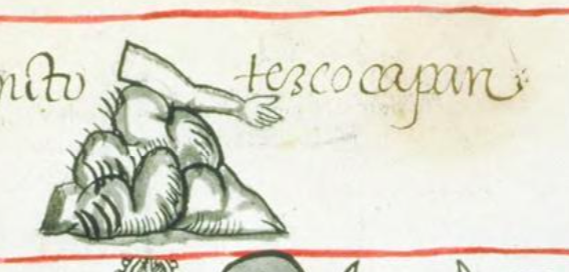Tetzcocapan (Chav13)
This black-line drawing of the compound glyph for the place name Tetzcocapan shows a frontal view of a much-contoured hill (probably a tetzcotl, or small hill). The hill has stones that are shaded--providing a three-dimensionality and European stylistic influence--and outlined. On the top is a human arm, reaching toward the viewer's right. Perhaps the arm is meant to conjure up the acolli that is usually translated shoulder, but can refer to a bend, providing the "co" phonetic element. Some grasses also grow on the hill. The -ca part of the place name may refer to the people of Tetzcoco (the Tetzcoca). The -pan (locative suffix), which means "on," may come from the arm being "on" the hill, but there is no logogram or phonogram to cover the -pan.
Stephanie Wood
tezcocapan
Tetzcocapan
Stephanie Wood
1578
hills, mountain, cerros, montañas, hierbas, piedras, brazo, mano, hombro, nombres de lugares

Tetzcocatl, someone from Tetzcoco, https://nahuatl.wired-humanities.org/content/tetzcocatl
tetzco(tl), a small hill, https://nahuatl.wired-humanities.org/content/tetzcotl
acol(li), shoulder, https://nahuatl.wired-humanities.org/content/acolli
-pan, locative suffix, https://nahuatl.wired-humanities.org/content/pan
En el pequeño cerro (?)
Stephanie Wood
The Codex Chavero of Huexotzinco (or Códice Chavero de Huexotzinco), https://www.loc.gov/resource/gdcwdl.wdl_03246_001/?sp=13
The Codex Chavero of Huexotzinco (or Códice Chavero de Huexotzinco) is held by the Instituto Nacional de Antropología e Historia, México. It is published online by the World Digital Library and the Library of Congress, which is “unaware of any copyright or other restrictions in the World Digital Library Collection.”



